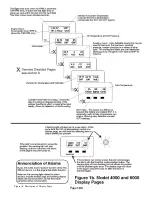
Page
111
The instrument should be secured using the mounting holes in the faceplate. Figure 4 provides the
physical dimensions of the instrument and a full-size mounting template. If the mounting template is
used, its dimensions should be verified, as paper may expand and contract with humidity.
NOTE:
No special consideration must be given regarding protection from vibration. The mechanical
design of the instrument is very rugged. This is of course not true of other instruments, especially
mechanical airspeed indicators and altimeters. The instrument does not emit electrical noise that will
interfere with any radios, and can be mounted next to a radio without concern. A magnetic compass
may also be located next to the instrument if desired, with no measurable effect, on or off.
5.2
Wiring
Figure 5a & 5b illustrates all electrical connections made to the EIS. The “Detailed Wiring
Description” below provides additional information about wiring the instrument into your aircraft.
Review this material to familiarize yourself before proceeding further.
Using this figure, start the wiring process by carefully planning and
DRAWING A WIRING
DIAGRAM
for your aircraft. The wiring diagram is essential in planning a successful installation.
Install the wiring, routing all wires required by the EIS to its planned location. A high-quality 22-
gauge stranded wire, 7 or 19 strands, is recommended for all connections other than those made to the
CHT and EGT probes. Solid conductor wiring is not acceptable. Thermocouple extension wire must
be used for the CHT and EGT probes to prevent the introduction of errors into these measurements.
CAUTION:
Use a separate ground wires for the ignition kill switches and the remainder of the
electrical system if possible. These separate ground wires should attach to different places on the case
of the engine so that both sets of grounds could not disconnect from the engine while remaining
connected to each other. This provides additional protection for the instrument (although its internal
protection is usually more than adequate), but more importantly, protects other electronic equipment in
your airplane from potential damage. See the sheet at the back of the manual for more information.
All electrical connections are made to the EIS via two 25-pin sub-D type connectors. Pre-wired, color-
coded cables are supplied with the instrument.
1) Start by making the power and tachometer connections as illustrated in figure 7. Note that 10.5-20
Volts DC, 0.20 Amperes is required to power the instrument. The instrument includes an internal
thermally activated fuse that protects the instrument. A fuse should be used in the aircraft wiring so
that a short in the wiring external to the instrument does not cause an electrical fire. Typically a fuse up
to 5 amps may be used for this purpose, depending on the wire gauge and lengths. This fuse may be
shared with other items, such as radios and such.
2) For proper operation of the instrument, the ground (black wire) from the instrument must be
connected to the case of the engine. Since most engines are grounded to allow operation of the electric
starter, only the connection from the instrument to the negative (-) terminal of the battery must be
considered. Ideally, the ground wire for the instrument should not be shared with other electrical
devices. If other devices share the ground wire used by the instrument, use a digital voltmeter to verify
the voltage difference between the case of the EIS, and the negative terminal of the battery is less than
20 mV with all electrical devices which share this ground wire turned on.
Содержание 912 Dragonfly
Страница 3: ...Page 2 ...
Страница 4: ...Page 3 ...
Страница 5: ...Page 4 ...
Страница 25: ...Page 24 Drawing 1 ...
Страница 27: ...Page 26 Drawing 2 ...
Страница 29: ...Page 28 Drawing 3 ...
Страница 31: ...Page 30 Drawing 4 ...
Страница 33: ...Page 32 Drawing 5 ...
Страница 35: ...Page 34 Drawing 6 ...
Страница 37: ...Page 36 Note for Hydraulic Brakes see Appendix B Drawing 7 ...
Страница 39: ...Page 38 Drawing 8 ...
Страница 41: ...Page 40 Drawing 9 ...
Страница 43: ...Page 42 Drawing 10 ...
Страница 45: ...Page 44 Drawing 11 ...
Страница 47: ...Page 46 Drawings 12A 12B ...
Страница 49: ...Page 48 Drawing 13 ...
Страница 51: ...Page 50 Drawing 14 ...
Страница 53: ...Page 52 Drawing 15 ...
Страница 55: ...Page 54 Drawing 16 ...
Страница 57: ...Page 56 Drawing 17 ...
Страница 59: ...Page 58 Drawing 18 ...
Страница 61: ...Page 60 Drawing 19 ...
Страница 63: ...Page 62 Drawing 20 ...
Страница 65: ...Page 64 Drawing 21 ...
Страница 67: ...Page 66 Drawing 22 ...
Страница 69: ...Page 68 Drawing 23 ...
Страница 71: ...Page 70 Drawing 24 ...
Страница 73: ...Page 72 Drawing 25 ...
Страница 75: ...Page 74 Drawing 26 ...
Страница 77: ...Page 76 Drawing 27 ...
Страница 79: ...Page 78 Wiring1 jpg Drawing 28a ...
Страница 80: ...Page 79 Wiring2 jpg Drawing 28b ...
Страница 81: ...Page 80 elecLights jpg Drawing 28c ...
Страница 83: ...Page 82 Drawing 29 ...
Страница 85: ...Page 84 Drawing 30 ...
Страница 92: ...Page 91 Appendix B Brakes Manual for BX1320 BX1000 Appendix B Page 1 ...
Страница 93: ...Page 92 Appendix B Page 2 ...
Страница 94: ...Page 93 Appendix B Page 3 ...
Страница 96: ...Page 95 Appendix B Page 5 ...
Страница 97: ...Page 96 Appendix B Page 6 ...
Страница 98: ...Page 97 Appendix B Page 7 ...
Страница 104: ...Page 103 Figure 1a Description of Display Pages ...
Страница 105: ...Page 104 Figure 1b Description of Display Pages ...
Страница 138: ...Page 137 Appendix C EIS 4000 912 914 ...
Страница 139: ...Page 138 Appendix C EIS 4000 912 914 ...
Страница 140: ...Page 139 Appendix C EIS 4000 912 914 ...
Страница 141: ...Page 140 Appendix C EIS 4000 912 914 End Appendix C ...
Страница 155: ...Page 154 Appendix E2 Powerfin Prop Page 2 ...
Страница 156: ...Page 155 Appendix E2 Powerfin Prop Page 3 ...
Страница 157: ...Page 156 Appendix E2 Powerfin Prop Page 4 ...
Страница 158: ...Page 157 Appendix E2 Powerfin Prop Page 5 ...
Страница 159: ...Page 158 Appendix E2 Powerfin Prop Page 6 ...
Страница 160: ...Page 159 Appendix E2 Powerfin Prop Page 7 ...
Страница 161: ...Page 160 Appendix E2 Powerfin Prop Page 8 ...
Страница 162: ...Page 161 Appendix E2 Powerfin Prop Page 9 ...
Страница 163: ...Page 162 Appendix E2 Powerfin Prop Page 10 ...
Страница 164: ...Page 163 Appendix E2 Powerfin Prop Page 11 End of Appendix E2 ...
Страница 187: ...Page 186 By Memphis Soaring FIGURE 3 Common Signals ...




































